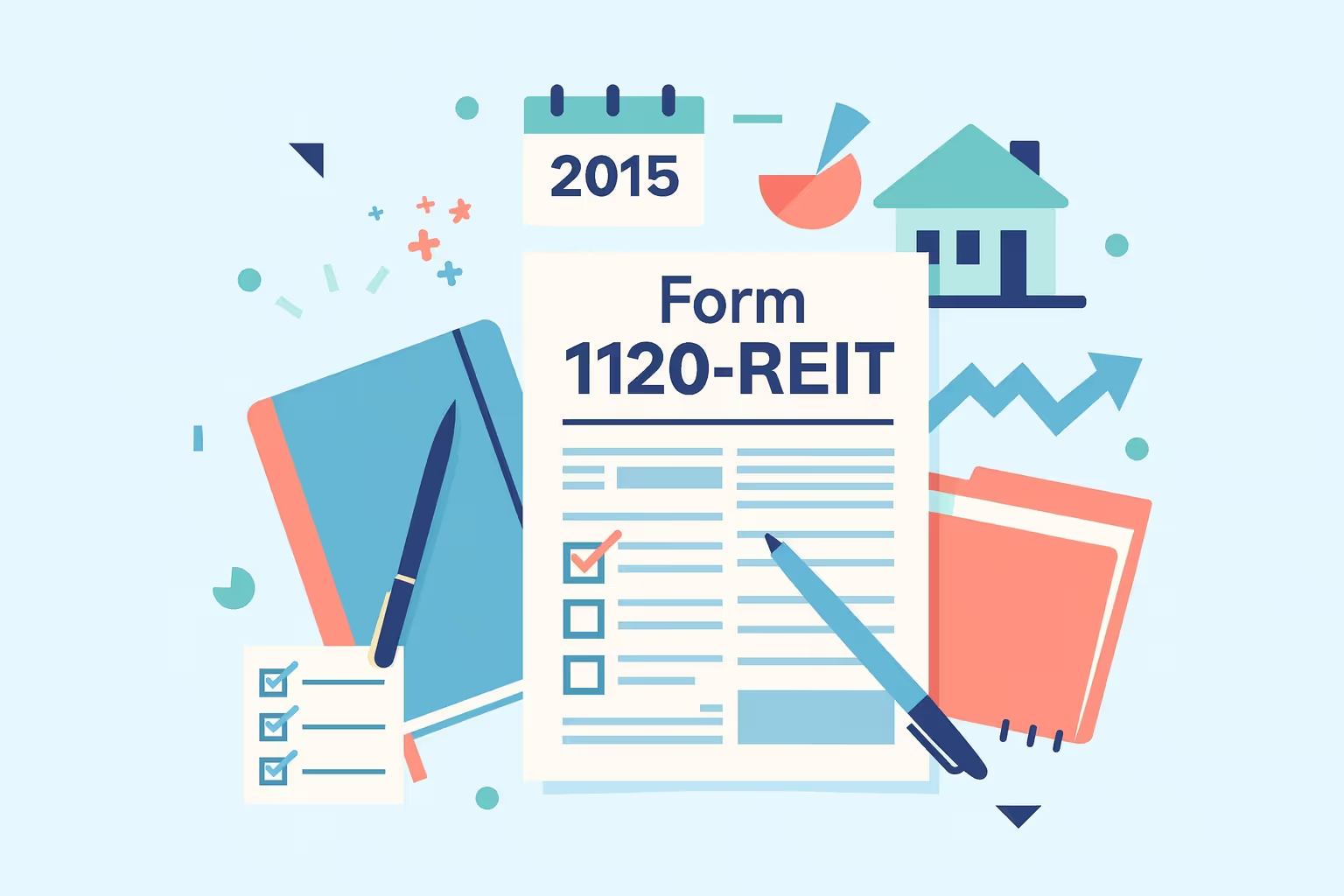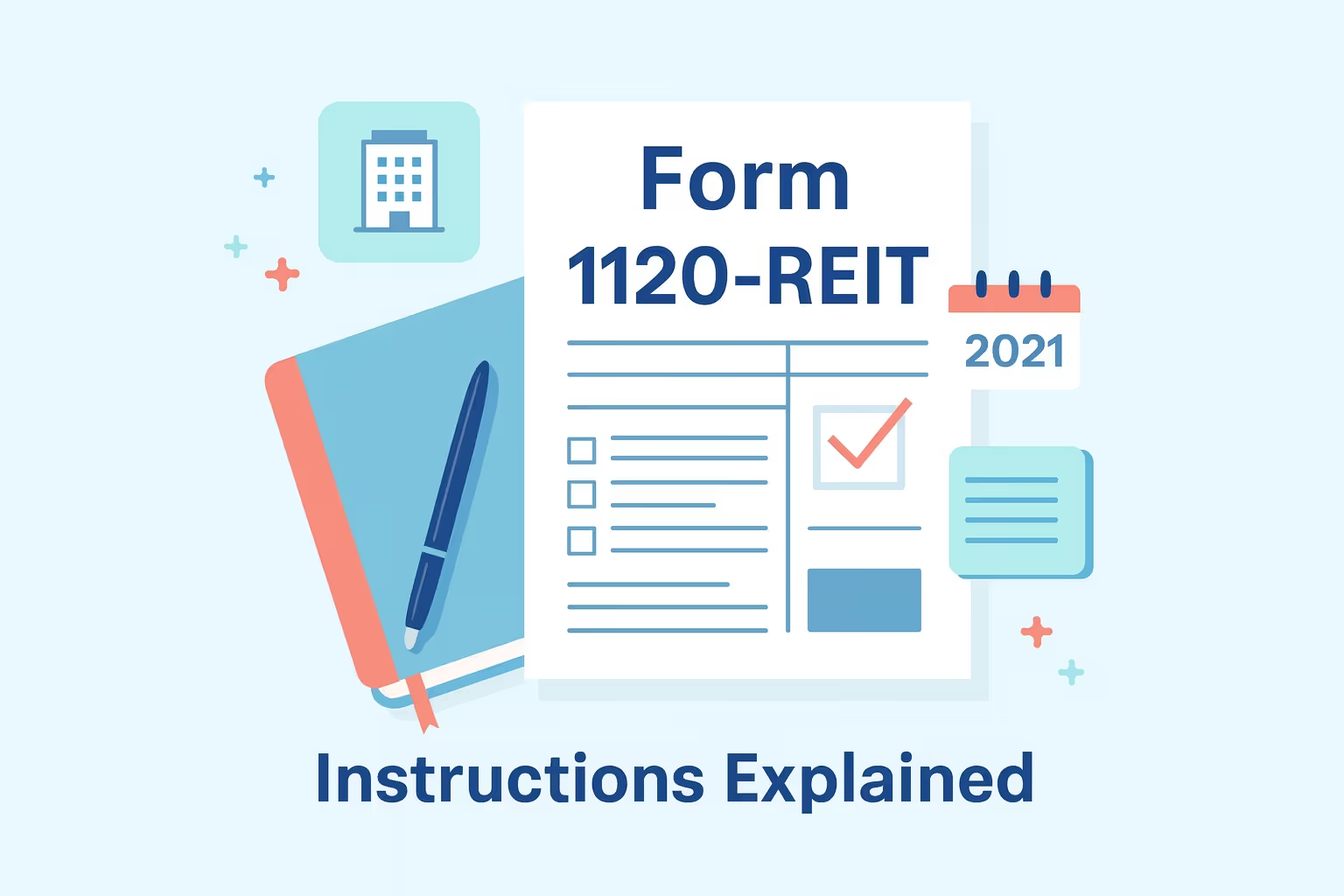
Form 1120-REIT is the U.S. Income Tax Return used by Real Estate Investment Trusts (REITs) to report income, deductions, and distributions for a specific tax year. For 2014, the Internal Revenue Service provided detailed instructions for Form 1120-REIT to guide corporations and businesses that elect to be treated as REITs. Filing this return allows a REIT to calculate its taxable income, claim credits, and show compliance with federal income tax rules. Although REITs enjoy special treatment by avoiding corporate-level taxation when distributing most of their taxable income to shareholders, they must still meet strict filing and reporting requirements.
The 2014 version of the return included updates affecting how certain expenses were deducted, how built-in gains were calculated, and how installment agreements could be requested. REITs needed to pay close attention to the original due date, estimated tax payments, and penalties for late filing. Just like individuals, S corporations, and partnerships, REITs are required to file their tax returns on time, honor payment deadlines, and avoid interest or additional fees that may be charged when obligations are missed.
Because this return affects money owed, potential refunds, and the ability to remain qualified as a REIT, it is crucial to obtain accurate information and follow the required steps carefully. Even when a REIT has little or no activity for the year, it must file on behalf of shareholders. The IRS expects the return to be complete, accurate, and submitted by the filing deadline, whichever date applies, to avoid unnecessary demands for payment or further response.
What Is Form 1120-REIT?
Form 1120-REIT is the U.S. Income Tax Return for Real Estate Investment Trusts. This specialized return is required for corporations, trusts, and specific associations that elect to be treated as REITs under federal tax law. The form is used to calculate taxable income, apply credits, and report distributions made to shareholders. By filing this return, REITs ensure they remain compliant with the Internal Revenue Code and maintain eligibility for favorable tax treatment.
Entities Required to File
A corporation, trust, or association must file Form 1120-REIT if any of the following apply:
- The entity has elected to be treated as a Real Estate Investment Trust.
- The election was made in a prior year and has not been revoked or terminated.
- The entity continues to meet REIT qualification requirements.
Basic REIT Qualification Requirements
To qualify as a REIT, an organization must meet several fundamental requirements:
- It must be organized as a corporation, trust, or association.
- Trustees or directors must manage it.
- It must issue shares or certificates of beneficial ownership.
- It must have at least 100 shareholders beginning in its second tax year.
- It must be a domestic corporation for tax purposes.
- It cannot be a financial institution or insurance company.
- It cannot be closely held after the first year of the election.
Filing this tax return enables REITs to report income, claim the deduction for dividends paid, and demonstrate compliance with annual income and asset tests. Meeting these requirements is essential for maintaining REIT status and avoiding corporate-level income tax.
Key Changes for Tax Year 2014
The 2014 tax year introduced several vital updates that affected how REITs filed their tax return. These changes involved expense deduction rules, recognition of built-in gains tax, and expanded payment options.
- Tangible Property Regulations: Final regulations under sections 162(a) and 263(a) provided new rules for deducting and capitalizing expenses related to tangible property. These rules generally applied to tax years beginning after 2013, but could also be applied retroactively to earlier years.
- Built-in Gains Tax Recognition Period: For 2014, the recognition period for the built-in gains tax was shortened to five years, giving relief to corporations that had converted to REIT status.
- Online Payment Agreements: REITs were allowed to request installment payment agreements online if they had an outstanding balance, making it easier to manage their payment obligations.
These changes made businesses need to carefully review the updated Form 1120 REIT 2014 instructions to avoid errors and ensure compliance.
Step-by-Step Filing Guide
Filing Form 1120-REIT requires accuracy and attention to detail. The IRS expects all information to be complete and consistent with official records. Each step in the filing process builds on the previous one, from entering identification information to calculating final taxable income.
Step 1: Complete Header Information.
The top of the form requests essential identification details.
- Enter the tax year (for this article, 2014).
- Provide the complete legal name and mailing address of the REIT.
- Enter the Employer Identification Number (EIN).
- Record the date the REIT was established.
- Report total assets at the end of the year.
- Identify whether the REIT is an Equity REIT or a Mortgage REIT.
- If an Equity REIT, include the Principal Business Activity (PBA) code.
Step 2: Report Income.
Income reporting is the foundation of the return.
- Dividends: Report income from both domestic and foreign corporations.
- Interest: Include all taxable interest earned.
- Gross rents from real property: Record rental income from owned real estate.
- Other gross rents: Include additional rental sources.
- Capital gain net income: Attach Schedule D (Form 1120) if applicable.
- Gains and losses from property sales: Report using Form 4797.
- Other income: Provide a statement with details if applicable.
Step 3: Report Deductions.
Deductions reduce taxable income and must be supported by records.
- Compensation of officers (Form 1125-E required)
- Salaries and wages, less employment credits
- Repairs and maintenance of properties
- Bad debts written off.
- Rental expenses paid by the REIT
- Taxes and licenses
- Interest expenses
- Depreciation (Form 4562 required)
- Advertising and promotional costs
- The attached statements support other deductions.
Step 4: Calculate Taxable Income.
After income and deductions are entered, taxable income is calculated.
- Subtract total deductions from total income.
- Apply the net operating loss deduction if available.
- Subtracting the dividends paid deduction is critical for REIT qualification.
- Apply any section 857(b)(2)(E) adjustments.
- Report the resulting REIT taxable income figure.
Step 5: Confirm and Attach Supporting Schedules.
The IRS requires additional forms and schedules to validate the information. Examples include Schedule A (Dividends Paid), Schedule J (Tax Computation), and Form 4626 for the Alternative Minimum Tax. Attaching the correct documentation ensures the return is complete and avoids unnecessary IRS requests.
Following each of these steps carefully allows REITs to calculate and file their tax return correctly. It also helps avoid mistakes that could result in penalties, interest, or questions from the IRS.
How to File Form 1120-REIT
Filing Form 1120-REIT can be done electronically or by paper, depending on the REIT’s size, resources, and preference. The IRS provides specific instructions for each method, and choosing the correct process helps prevent delays or penalties.
Step 1: Decide Between Electronic Filing or Paper Filing
- Electronic Filing (e-file): E-filing is encouraged because it speeds up processing, reduces errors, and provides immediate confirmation that the IRS has received the return. The system includes built-in validation checks that catch common mistakes before submission. While not always mandatory for REITs, electronic filing is the preferred option for many real estate investment trusts (REITs).
- Paper Filing: Paper returns are still accepted. The correct mailing address depends on the REIT’s total assets and state of incorporation. For example, REITs in certain eastern states with less than $10 million in assets mail their return to Cincinnati, while those with $10 million or more use the Ogden, Utah, IRS center. REITs from other states generally file with the Ogden office.
Step 2: Consider Private Delivery Services
The IRS permits the use of approved private carriers, such as FedEx and UPS, to meet timely filing requirements. However, these services cannot deliver to P.O. boxes. If the IRS address for the return is a P.O. box, the filer must use the U.S. Postal Service instead.
Step 3: Confirm Documentation and Deadlines
When filing, REITs must assemble the return in the correct order and include all required schedules and forms. It is essential to meet the original due date for the tax return to avoid penalties, interest, or additional fees. If additional time is required, filing Form 7004 for an automatic extension is an option, though payment obligations remain due by the original deadline.
Submitting Form 1120-REIT correctly ensures the IRS accepts the return, credits payments to the correct tax year, and avoids unnecessary delays or demands for additional information.
Payment and Deadlines
REITs must file Form 1120-REIT by the 15th day of the third month after the end of their tax year. For calendar-year filers, the due date for the 2014 return was March 15, 2015. If more time is needed, Form 7004 can be filed for an automatic six-month extension, but this only extends the time to file, not the time to pay. Any balance due must still be paid by the original due date to avoid penalties, interest, and additional fees.
Estimated tax payments are required if the REIT expects to owe $500 or more after credits. These payments must be made electronically, usually through the Electronic Federal Tax Payment System (EFTPS). Quarterly installments are due on the 15th day of the 4th, 6th, 9th, and 12th months of the tax year. REITs may also use same-day wire transfers if last-minute payments are necessary. Using a checklist to track the original due date, installment deadlines, and payment confirmations helps avoid underpayment issues and unnecessary charges.
Required Schedules and Attachments
Form 1120-REIT requires several supporting schedules and attachments to provide complete information to the IRS.
- Schedule A – Deduction for Dividends Paid: Calculates dividends paid during the tax year, dividends declared late in the year but paid by January 31, and any consent or deficiency dividends.
- Schedule J – Tax Computation: Shows the total tax liability, including taxes on REIT taxable income, foreclosure property, and prohibited transactions.
- Schedule K – Other Information: Provides details on accounting methods, ownership, dividend distributions, and tax-exempt interest.
- Additional Forms: These may include Schedule D for capital gains and losses, Form 4562 for depreciation, Form 4626 for alternative minimum tax, and Form 8612 for excise tax on undistributed income.
The IRS also requires the return to be assembled in a specific order, beginning with Form 1120-REIT, followed by schedules and additional forms. This ensures that the return can be processed efficiently without requiring clarification requests.
Common Mistakes to Avoid
REITs filing Form 1120-REIT often face issues that can result in IRS notices or penalty charges.
- Income and Asset Test Failures: Errors may occur when non-qualifying income is included in the 75% gross income test or when the 95% test is miscalculated. Similar mistakes happen if the 5% or 10% asset limits are overlooked.
- Distribution Requirement Errors: Failing to distribute at least 90% of taxable income or miscalculating dividend amounts can cause significant compliance issues.
- Tax Calculation Errors: Built-in gains tax or prohibited transaction tax is sometimes incorrectly calculated, particularly when applying recognition periods or safe harbor rules.
- Filing Errors: Missing or incorrect EINs, selecting the wrong tax year, omitting required schedules, or using the wrong mailing address can delay processing.
By carefully reviewing the IRS instructions, double-checking numbers, and ensuring that all schedules are included, REITs can avoid these common mistakes. Consistent attention to detail helps reduce the risk of penalties and ensures the return is accepted without unnecessary delays.
Filing Requirements for Zero Activity or Dormant REITs
Even when a REIT has little or no business activity during the year, it must still file Form 1120-REIT if the REIT election is in effect. Filing ensures that the entity continues to meet compliance standards and retains its status. Dormant REITs must maintain their organizational structure, keep shareholder requirements, and ensure they do not become closely held.
Key considerations for dormant REITs include:
- Reporting minimal or no income while still submitting a return.
- Maintaining at least 100 shareholders after the first year.
- Meeting the 75% real estate asset test even with cash or minimal investments.
- Considering nominal dividends if taxable income is present.
If a REIT no longer wishes to maintain its election, it must file a formal revocation with the IRS by the 90th day of the tax year. Revocation prevents the REIT from re-electing for four years without IRS approval. Careful planning is required before taking this step, as it can impact your long-term tax strategy.
First-Time Filer Tips
REITs filing Form 1120-REIT for the first time face unique challenges. Proper preparation and organization are essential for compliance.
- Documentation: Collect governing documents, shareholder records, property valuations, and prior tax returns if converting from another entity.
- Making the Election: Filing Form 1120-REIT for the first year serves as the election to be treated as a REIT. This election remains effective until it is revoked or terminated.
- Compliance: New filers must ensure they meet organizational, income, and asset test requirements from the start.
- Common Challenges: Errors often occur in tracking qualifying income, monitoring asset limits, and scheduling distributions. These can be reduced by creating systems for recordkeeping and compliance.
Engaging professional tax advisors or specialized REIT accountants during the first year can help prevent mistakes and establish strong reporting practices.
Special Compliance Considerations
Maintaining REIT status requires meeting ongoing qualification tests, distribution requirements, and understanding excise tax rules.
- Qualification Tests: REITs must pass several tests, including the 75% real estate asset test and the 95% gross income test, as well as ownership limits such as the 5% and 10% rules. These tests apply quarterly or annually, depending on the requirement.
- Distribution Requirements: At least 90% of taxable income must be distributed to shareholders each year. Distributions can be made in cash, property, or through consent dividends. Timing is essential, as specific year-end declarations can be counted toward compliance.
- Excise Tax and Penalties: A 4% excise tax applies if sufficient distributions are not made. Other penalties include taxes on prohibited transactions and fines for ownership violations.
Monitoring compliance throughout the year rather than waiting until filing time helps avoid costly errors and ensures the REIT continues to qualify for favorable tax treatment.
Frequently Asked Questions
What are the instructions for Form 1120 REIT 2014?
The Form 1120-REIT 2014 instructions provide corporations, trusts, and businesses that have elected REIT status with the official guidance on how to file their tax return. These instructions outline the process for calculating income tax, credits, and deductions, as well as the required schedules and attachments. They help filers avoid mistakes, penalties, and fees by providing the correct information needed to complete the return on behalf of shareholders.
When is the due date for filing your tax return?
The original due date for a REIT’s 2014 tax return was March 15, 2015, or the next business day if that date fell on a weekend. Corporations and partnerships must comply with this deadline, as late filing may result in penalties, interest, or an IRS demand for payment. To avoid charges, a REIT may file for an extension; however, payment of any balance owed remains due by the original deadline.
Do REITs need to make estimated tax payments?
Yes, if a REIT expects its income tax liability to be $500 or more after credits, it must make estimated tax payments throughout the year. Payments are due in four installments, as applicable, and must be made electronically. Using EFTPS with a locked padlock icon ensures secure processing. Failure to pay on time can result in underpayment penalties, multiplied charges, and additional interest.
What happens if a REIT does not file or pay on time?
If a REIT fails to file its return or pay the balance due by the original due date, it may incur penalties, interest, and additional fees. The IRS can issue a request or demand for payment, which increases the total money owed. For example, penalties may be calculated monthly and multiplied by the number of months the payment is late. Filers should check dates carefully and honor all obligations to avoid unnecessary charges.
Can REITs receive a refund if they overpay for a property?
Yes, if a REIT pays more than the required income tax, it may request a refund. The IRS will review the return and process credits or overpayments on behalf of the filer. Refunds may be applied toward future payments or returned directly as money. To receive a refund, the REIT must file accurately, include the correct information, and avoid errors that delay the response or trigger additional IRS review.
How do REITs compare with S corporations and partnerships?
Unlike S corporations or partnerships, which pass income directly to shareholders or partners, REITs must file Form 1120-REIT and distribute at least 90% of taxable income to maintain their status. The filing requirements differ, but all businesses must meet the time-to-file rules, submit accurate information, and pay taxes or estimated amounts when due. Each entity type is updated annually with rules that help avoid penalties and protect compliance.



































